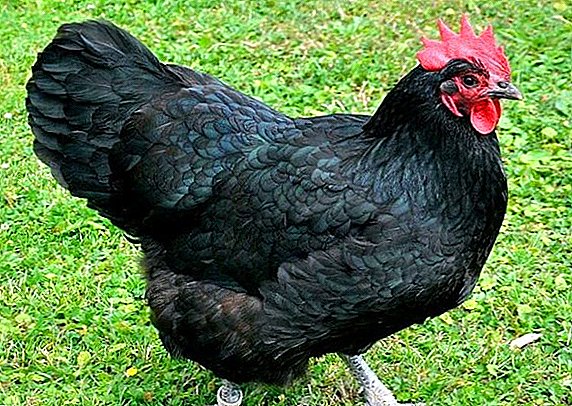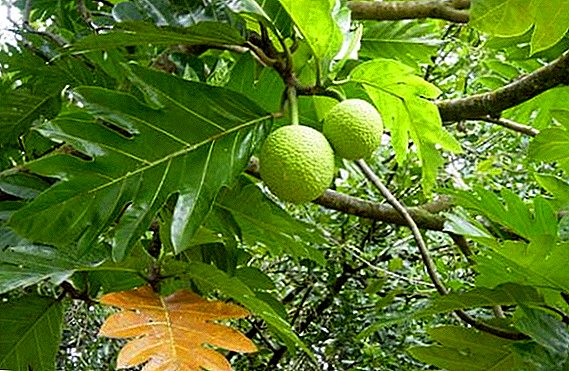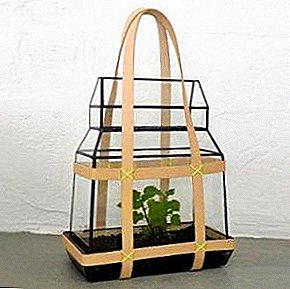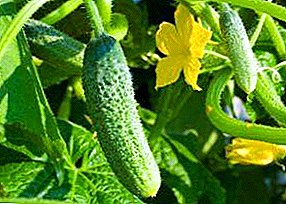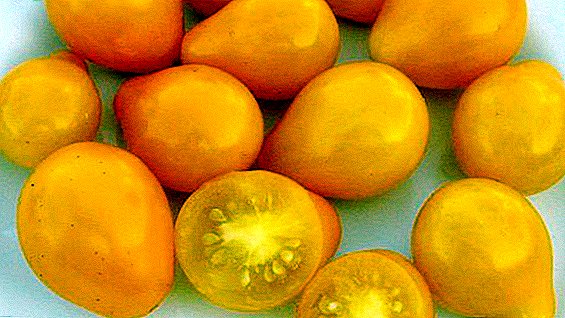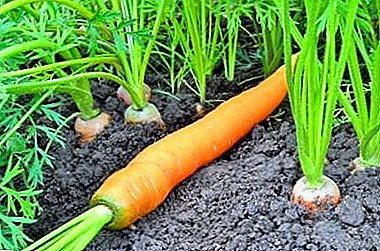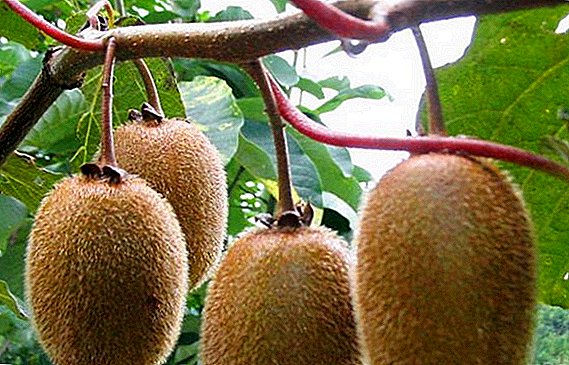 Kiwi - one of the most popular exotic fruits, which can be found on the shelves of almost all stores. If you love these green shaggy fruits, then we have good news for you: you can grow kiwi fruit at home. In our article we will explain how to do this using only seeds from the fruit.
Kiwi - one of the most popular exotic fruits, which can be found on the shelves of almost all stores. If you love these green shaggy fruits, then we have good news for you: you can grow kiwi fruit at home. In our article we will explain how to do this using only seeds from the fruit.
Requirements for growing kiwi at home
In order for the plant to start and grow, as well as yield a crop, it is important to comply with certain requirements:
- Kiwi loves light and heat, so the pot should be placed on the windowsill on the sunny side;
- ensure that it is protected from drafts;
- the plant loves moisture, therefore it is recommended to spray it daily;
- make sure that the soil is also always hydrated, but it is not worth pouring the sprout.

Important! For the cultivation of kiwi fruit you should choose a spacious room, as the vine grows quickly and it can become crowded, and the date of the crop can move indefinitely.
Remember that kiwi is an exotic fruit, and for its normal development it is necessary to create as close as possible to natural conditions.
Growing process
The cultivation process includes several stages, each of which is important and can affect the yield of the plant.
Find out whether it is possible to grow at home and such an exotic fruit as guava, longan, annona, feijoa, bail.
Seed preparation for planting
To extract the seeds from the fruit, you need to choose a fresh kiwi, which is well matured.
The process includes the following steps:
- the pulp of the fruit must be kneaded with a fork;
- move the gruel into a gauze bag, which should be folded in 2-3 layers beforehand;
- rinse the bag until the pulp is completely removed;
- the seeds that remain in the gauze must be removed and put on a sheet of paper; the leaf is left at room temperature so that the seeds dry out properly, make sure that they are not exposed to direct sunlight.

After extracting the seeds, they begin to stratify. To do this, the planting material must be mixed with sand, placed in a lockable container and left in the refrigerator in the vegetable compartment for 2-3 months.
During this period, it is important to ensure that the sand is always wet, from time to time it is necessary to ventilate the container. After the "artificial winter" is completed, planting material can be used for planting.
Before sowing the seeds, it is necessary to germinate them. Place a cotton pad on the saucer that is pre-moistened with hot water. On it lay the seeds in an even layer.
In order for the seeds to germinate, greenhouse conditions must be created. It is necessary to cover the plate with polyethylene, and at night it should be removed, and in the morning put it on again, adding some water to the cotton pad. In about 2 weeks the seeds will germinate - this indicates their readiness for planting in the ground. 
Soil preparation
For planting seeds should choose medium-sized pots. Ideal for Kiwi is suitable light fertile soil with low acidity. Soil can be purchased in specialized stores or cook yourself.
To do this in the same proportions you need to mix humus, sand, peat, leaf and sod land. Before embarking, the mixture must be subjected to heat treatment.
Planting germinated seeds in the ground
The process of planting includes the following steps:
- At the bottom lay the drainage layer.
- On top of the drainage sprinkle prepared soil mixture.
- In the soil make holes, the depth of which is not more than 5 mm.
- Put the planting material into the wells, cover it with a thin layer of soil and slightly moisten it.
- The pot or container is covered with a plastic film, placed in a warm and bright room.

Did you know? In 1992, a new variety of kiwi was obtained in New Zealand. It has an unusual golden color of flesh and high cost.
Every day the shelter must be removed and airing the landings, their watering.
Kiwi care details
After 4 weeks, several leaves will appear on the sprout. It is during this period that the picking is carried out - the seedlings are seated in separate small pots. Kiwi has a very delicate superficial root system, so you should carefully get the seedlings from the common container.
If the roots are damaged, the plant may die.
When the kiwi is transplanted into pots, it is very important to add a little compost to the prepared soil mixture. Further feeding should be carried out from March to September every 2 weeks.  Ideal for this mineral fertilizer.
Ideal for this mineral fertilizer.
Mineral fertilizers also include such as Kemira, Sudarushka, Ammophos, Plantafol, Master, and Azofoska.
Kiwi is a moisture-loving plant, and it is very important to prevent the soil from drying out.
It should always be wet, but overflow can cause the roots to rot. Choose pots that have drainage holes to drain excess water out of the ground.
Be sure to ensure that the water does not stagnate in the pan. In the hot period it is recommended to spray the plant daily.
To obtain the harvest, besides ensuring an adequate level of illumination, regular moistening and proper fertilizing, it is necessary to carry out other activities.
It is mandatory to make the support. They are needed in order to climb up the vine. To improve branching, it is necessary to regularly nip plants. 
Do not forget that in order to obtain the harvest, it is necessary to perform cross-pollination of male and female flowers. If it is carried out, the first fruits can be collected 6-7 years later after planting.
Vegetative propagation of kiwi
In addition to growing kiwi from seed, there are other methods of reproduction. Consider them in more detail.
In the split hardened handle
To use this method, you need hardened cuttings that contain at least 3 buds. Be sure to cut diagonally the lower edge under the lowest kidney, and above the top you should leave a distance of 1 cm.
Important! In the autumn and winter periods, the soil should be moistened only if the surface layer is completely dry, otherwise the root system may rot.

After that, the planting material must be placed in water and add a growth stimulator (you can use the drug "Kornevin"). In a container with water, the plant should stay for at least 12 hours.
Then you need to prepare the seed boxes, at the bottom lay out a layer of drainage, on top - the prepared mixture, which includes peat and sand in equal parts.
Then the cuttings are planted in a container, they are moistened, the top is covered with glass jars and left in a dark place with good lighting.
Every day you need to remove the jar and spray the seedlings, and, if necessary, water them. After 3-4 weeks the seedlings should have a root system. From this point on, it is possible to plant in separate pots with a drainage layer and specially prepared soil.
In cleft green cutting
For the implementation of this method is to use the green cuttings, harvesting which is performed during the summer pruning. They must necessarily be 2-3 buds. 
The lower cut is carried out at an angle of 45 degrees, and the upper cut is performed 1 cm above the uppermost bud, exactly. Then the cuttings should be placed in a container with water (4-5 cm), cover with paper and leave for 24 hours.
Vocabulary
The simplest method of budding (grafting) is budding in the butt, as it can be done both in spring and in summer, provided that the air temperature is above +10 ° C. First of all, you need to pick a plant stock. Below the budding area of 40 cm, it is necessary to remove all leaves and shoots.
With a graft, only a few fresh shoots should be cut, and it is important that they already have buds on them. On the stock at an angle of 45 degrees, it is necessary to make a cut, whose length is 6-7 mm, after which a second cut is made 3 mm higher. 
It must be led down so that it connects with the first. The graft is worth the same procedure on the graft, only the kidney should be located in the middle of the shield. The flap with the kidney should be placed in a cut on the stock and wound with a polyethylene ribbon.
Why does the plant die
The main reasons for the death of a plant include:
- insufficient moisture or over-irrigation;
- bad light;
- lack of useful elements in the ground;
- defeat plants fungal diseases and pests.
The most common diseases include:
- shield;
- aphid;
- spider mite
- remove all affected foliage and areas of the stem;
- get the plant out of the tank, flush the root system and remove its rotten parts;
- to transplant Kiwi into clean soil;
- spray the plant and irrigate the soil with a fungicide solution.

Did you know? Kiwi has the ability to ripen even after harvest.
When pests appear on kiwi:
- pruning of withered and dried leaves;
- All parts are washed with a solution of household soap;
- spraying is carried out with a special extract, which contains garlic, onion, tobacco or wormwood;
- in the absence of effectiveness from spraying infusion, resort to the use of insecticides.
Growing kiwi at home is a very long process, and if you set a goal for yourself to get a harvest, then you have to spend a considerable amount of time on this. But you can brag of independently grown exotic fruit.
Feedback from network users





